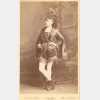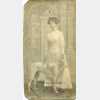| Profile | Posted by | Options | Post Date |

|
JaneyCanuck
|
Report
|
15 Jul 2009 02:32 |
|
Susan with numbers! Enjoy. ;)
Re the military artist bit -- I was mainly just offering that up as a possible explanation for the locales and times of the artwork you have, Allan, not meaning that the specific one in question was a person of interest. It would certainly fit the circumstances -- Ireland, Canada, and the subject matter?
|

|
Allan
|
Report
|
15 Jul 2009 02:52 |
|
Hi JaneyCanuck
The Ireland/Scotland scenes are mainly landscapes. The Toronto ones may be of a military basis, but may have also just been "tourist" type sketches.
I did try the web site you posted was was unable to view the page
Regards
Allan
|

|
JaneyCanuck
|
Report
|
15 Jul 2009 15:37 |
|
This one?
http://journals.sfu.ca/archivar/index.php/archivaria/article/download/11615/12562
It should prompt you to open a pdf file using your default viewer.
Like I said, it's tangential, but it's kind of interesting and could provide some little bit of background info.
---------------------------------------------------------------------------------------
Captain George St. Vincent Whitmore:
A Newly Discovered Military Artist
In November 1987, the National Archives of Canada acquired a watercolour
by Captain George St. Vincent Whitmore of the Royal Engineers, entitled
Aurora Borealis, Quebec, (Fig. 1) and dated 1837. In addition to being an
important and rare record of a spectacular phenomenon, this watercolour
has also led to the identification of the artist responsible for an album of
watercolours which has been in the Archives' holdings since 1970. This
article relates the method by which the identity of Captain Whitmore was
established by using records in the Manuscript Division and in the
Cartographic and Architectural Archives Division in conjunction with
records in the Documentary Art and Photography Division.
... Whitmore lived in Kingston for two years; however, no views by him
of this area have yet been found. Since he did not sign his watercolours,
these pictures - if indeed they exist - may be languishing in some collection,
attributed to yet another unknown artist. Our discovery will perhaps lead
to their identification.
---------------------------------------------------------------------------------------
You might even consider sending images of what you have to the National Archives in Canada to see whether they could tell you anything!
|

|
Allan
|
Report
|
15 Jul 2009 22:46 |
|
Many thanks for that, JaneyCanuck
I may just take you up on your suggestion, although given that he was in Quebec in 1837, and some of the sketches in the book are of Ireland and Scotland in the early1840's they are probably not by him.
I'm not sure how long the tour of duty was back then, but I know that these days it is usually about two years (in areas where peace reigns!)
Regards
Allan
|

|
JaneyCanuck
|
Report
|
16 Jul 2009 00:48 |
|
I'm still being unclear. ;)
I'm not really suggesting that the artist who is the subject of that article is your person.
The article just gives some interesting background info -- similar work, same time period, overlapping places. Your person *could* have been in Canada with the military, even if he was not a military artist.
What I meant, about the National Archives, is that they seem to have considerable expertise in this regard, and someone there might be able to make some educated guesses about the nature and origin of the works you have.
The website is geared to accessing documents in the collection, but you could start with any contact and get steered in the right direction.
http://www.collectionscanada.gc.ca/the-public/index-e.html
|

|
Allan
|
Report
|
16 Jul 2009 01:10 |
|
Thanks JaneyCanuck,
You were clear, it was me that didn't put it clearly: I certainly dont expect it to be the same person, but I had no idea how to proceed with trying to identify the artist, if indeed he/she can be identified.
It's going to be one of those days!!!
Just went to use my printer/scanner and the bl**dy thing is dead
Once again Janey, thanks for your help, and for the various addys. I am off to buy a new printer
Regards
Allan
|

|
JaneyCanuck
|
Report
|
16 Jul 2009 01:23 |
|
I shall not give up. ;)
http://calvinpark.limestone.on.ca/projects/canadiancommunities/attractions/museums/martello.html
The Martello Towers - Murney, Fort Fredrick, Shoal, and Cathcart - were built to help Fort Henry protect Kingston from American attack.
The Towers were never used in battle, but they were used as barracks for soldiers stationed in Kingston.
When Were they Built?
Although construction of all of the Towers began in 1846, some were not totally completed until 21 years later in 1867. The Murney Tower was completed first, requiring only a brief four months of construction. The towers were not considered finished until they were fully equipped and armed with cannons.
Cedar Island is the location of Cathcart Tower. As I pasted in your other thread:
Cedar Island, located just off the shore from historic Fort Henry, is the site of Cathcart Martello Tower, one of four such towers built in the 1840s to protect Kingston's harbour and the entrance to the Rideau Canal. Their construction was prompted by a dispute between Great Britain and the United States over the boundary between British Columbia and Oregon that threatened to lead to war and to the invasion of Canada.. When war was averted, Cathcart Tower was used for a time as a barracks for soldiers garrisoned at nearby Fort Henry.
(I make the connection now with Murney tower, the Martello tower I toured in Kingston a couple of summers ago. The cannonballs are still there. I love that stuff.)
I can't imagine that anyone not associated with the military would have been on Cedar Island -- the location of a fortified construction built in anticipation of a cross-border war -- circa 1850. It was a military barracks for the British military -- remember that Canada did not achieve complete self-government until 1867, and some Brit troops even hung around a while after that. The military defending "Canada" (in its various bits) before 1867 was entirely British -- many of the actual troops being Irish, notably.
I would bet much money that the painter of the works you have was in the military. Not necessarily a "military artist" -- many men in the British military engaged in watercolour painting as a hobby, my grandfather among them. (Unfortunately for my family, my wicked aunt has what remain of his pre-WWI works.)
I would get in touch with Fort Henry directly to ask what regiment was garrisoned there and whether there is any info extant about individuals.
This is the general contact page:
http://www.parks.on.ca/fort/contact.php
and I would start by asking where to direct this kind of historical inquiry.
Aha. The present Curator is named Ron Ridley and his contact info is here:
http://www.museumsontario.com/museums/onlineguide/details.aspx?ContactID=708
He seems quite passionate about the job and I imagine he would be very pleased to hear from you.
|

|
Allan
|
Report
|
16 Jul 2009 02:07 |
|
Once again, my thanks
|

|
Allan
|
Report
|
21 Jul 2009 02:59 |
|
JaneyCanuck,
Have sent a copy of the sketch to Ron Ridley.
Many thanks for the contact address
Regards
Allan
|

|
Allan
|
Report
|
11 Sep 2009 00:24 |
|
Nudging for SueMaid
Regards
Allan
|

|
Allan
|
Report
|
22 Sep 2009 23:18 |
|
JaneyCanuck,
I have now had a response from Ron Ridley and have received a list of Army Units which served at Fort Henry at the relevant time. He has also asked me to rescan the sketches in a different format to see if the details can be enhanced.
Many thanks for you help
Regards
Allan
|

|
JaneyCanuck
|
Report
|
22 Sep 2009 23:58 |
|
That's great! He sounds interested, so maybe he'll come up with something.
|

|
Allan
|
Report
|
11 Nov 2009 09:16 |
|
JaneyCanuck
This is the response received today from Ron Ridley.
I had been trying to get the sketches to him in a format that would be able to be enlarged
Dear Allan,
My apologies for not being able to get back to you sooner. I have been assigned addtional duties regarding a visitor centre and my priorities have been re-arranged to meet rather tight deadlines.
Thank you for sending the recent j-peg image of the Fort from Cedar Island. I was able to open the sketch of Fort Henry quite easily and it is much clearer and of a much higher resolution that the PDF versions that you sent earlier. The Jpeg format has a compression effect built into it, which is why it is used so much on the web. I am by no means an expert in this. The last image that you sent is great. I cropped it down to the size of the sketchbook page and that also reduces the size of the image by almost half. The resulting image shows quite a bit more detail than the initial one.
We have been trying to determine the form of the flagpole, which from your last, higher resolution image, we can now see that is also being used as a signal mast. We suspected this for some time, but this is the first confirmation of this use. Surprisingly, there are not many images of Fort Henry that show this much detail and this drawing is very useful to us because it opens up the whole new dimension of signal communications during that period.
I have also shown the images of Toronto that you sent previously to my colleagues in that city and they are also quite interested as this is also a fairly sparse period of images for them as well. We are all quite intrigued to determine who the artist was. We are all fairly convinced that the individual had some training in drawing, as the skill level is quite high. If you recall any family references to someone in the military, it may be of help. You mentioned that the sketchbook contains previous sketches of Scotland. Are there many and are any of them of military subjects? Would it be possible for you to send the other sketches of Toronto in the format that you sent the last Fort Henry image?
Would you be willing to grant use of the images to Fort Henry National Historic Site? We would very much appreciate it as it, as an image such as this adds so much to our understanding of the site. With your permission, I would like to forward your contact information to my Toronto contacts, who would also be interested in speaking to you directly in the same regard.
Again, I would like to thank you for letting us know about the sketches. It is always causes such a buzz among historians when a new image comes to light.
I have taken a couple of photographs of Cedar Island from the Fort, but am dealing with my own lack of technical skills. I hope to be able to download it soon from my camera and promise to send you off a couple of shots to show you how the island looks today and where the sketch was drawn from.
(Note that I will be away from my computer for tomorrow, Remembrance Day, and tied up in the interminable meetings for a day or so after. My apologies.)
Regards,
|

|
JaneyCanuck
|
Report
|
11 Nov 2009 14:44 |
|
That is just terrific!
So let me take this opportunity to thank you (on an appropriate day), from all Canadians, for your contribution to our historical record!
I know it hasn't got you anywhere yet -- but hey, was I right or was I right? I said I thought he'd be interested in your cache of historical objects. ;) I didn't know *how* interested, of course!
Really, that's tremendous, and I do thank you.
Hopefully, as you follow up, something more will come out of it for you too. ;)
|

|
Allan
|
Report
|
11 Nov 2009 21:34 |
|
Thanks, Janey,
I have now sent the other images of to Ron plus I have found a name in the book, J A (or G) Carfrae with an address 49 Essex Street. No location given for the Street.
The name means nothing to me at the moment but it is another avenue if my G/F was aopted
I just wanted to let you know about the sketches as a way of thanking you for all your help
Regards
Allan
|

|
JaneyCanuck
|
Report
|
11 Nov 2009 22:32 |
|
http://www.scottisharchitects.org.uk/architect_full.php?id=200307
John Alexander Carfrae, bio
This is the architect John Alexander Carfrae in 1901 and 1881:
1901 Scotland Census
Name: John Alexr Carfrae
Age: 33
Estimated Birth Year: abt 1868
Relationship: Head
Where born: Edinburgh
County: Midlothian
Address: No 9 Hope Park Ter
Occupation: Architect
John Alexr Carfrae 33
Maggie Dickson 40 - stepsister, governess
Lillias Cath Margt Dalgleish 18 - cousin, housekeeper
1881 Scotland census
Name: John A Carfrae
Age: 13
Estimated Birth Year: abt 1868
Relationship: Son
Mother's Name: Catherine
Where born: St Cuthberts, Edinburgh
Civil parish: Edinburgh St Giles
County: Midlothian
Address: 81 Clerk Street
Catherine Carfrae 47
Maggie Dickson 20
John A Carfrae 13
That seems to be the name in the book, or at least what you surmised earlier.
In 1871, his name is spelled Carfray, and his father Alexander is in the household. Ancestry has cleverly transcribed the parents' surname as Carpel. Unfortunately the image can't be viewed. Father Alexander's occupaton is engraver. Margaret Dickson appears to be Catherine's daughter; Ancestry has transcribed her as granddaughter, but I expect it should be stepdaughter.
Certainly an interesting sidelight!
|

|
Allan
|
Report
|
11 Nov 2009 23:25 |
|
Janey,
Thanks for that.
Once I had a name I googled and it brought up the Architect J A Carfrae.
The 1868 birth is a bit out of wack with the dates of the sketches which were all done in the 1844-1850 period, although of course they could still be related.
I'm still trying to figure out how this could relate to Clifford born circa 1860. In the 1911 census, Clifford's place of birth is given as London
Hopefully it is at least a lead
Kind regards
Allan
|

|
JaneyCanuck
|
Report
|
12 Nov 2009 00:10 |
|
I wonder whether it might possibly have been John Carfrae's father Alexander who did the sketches.
1851 census
Name: Alexr Carfrae
Age: 21
Estimated Birth Year: abt 1830
Relation: Soldier Inmate (Soldier)
Where born: Scotland
Condition as to marriage: married
Occupation: Private, 79th Regiment Army
Civil parish: Berwick Upon Tweed
Town: Berwick Upon Tweed
County/Island: Northumberland
ED, institution, or vessel: Barracks and Garrison Hospital of Berwick upon Tweed
http://archiver.rootsweb.ancestry.com/th/read/UK-79TH-REGIMENT/2005-02/1108585089
The 79th Regt was in Montreal 1825-1835; Montreal is a couple of hours (today!) from Kingston / Fort Henry.
Or Alexander's father, more likely.
Google
"In May, 1833, the regiment was removed from Toronto to Quebec"
and you'll get a book called "Historical records of the 79th Queen's Own Cameron Highlanders", which appears to be the thing.
A conceivable candidate for Alexander's father in 1841:
Name: William Carfraes
Age: 34
Estimated Birth Year: abt 1807
Where born: Midlothian, Scotland
Civil parish: Edinburgh High Church
County: Midlothian
Address: 357 High Street Advocates Close
>> Occupation: Printer I
William Carfraes 34
Alison Carfrae 30
Alexander Carfrae 14
Thomas Carfrae 12
Mary Carfrae 6
|

|
Allan
|
Report
|
12 Nov 2009 06:46 |
|
Janey,
I'm sorry not to reply immediately but given the time difference between us and the fact that I am now working part-time until the end of this month, it makes 'instant' replies impossible.
I will check out the posible Carfrae connection.
With respect to the sketches, I am pleased that these will help a little with the history of Toronto.
What a total waste if they should have been just discarded at this end if no one saw the connection
Kind Regards
Allan
|

|
Allan
|
Report
|
9 Jun 2010 22:35 |
|
Janey,
no new leads although I am still following the Carfraes.
However, I just thought that I would let you know that another one of the Canadian sketches has been found to be of historical value.
I have received an email from Dr Aldona Sendzikas who is an Associate Professor in the Dept of History at the University of Western Ontario.
Dr Sedzikas is writing a history of the Stanley Barracks. These were apparently constructed in 1840-41 to replace the old Fort York. The "new" fort was renamed Stanley Barracks in 1893.
It seems that there are very few sketches of the fort in the early years and the sketch I have titled "Barracks, 29th July 1848" is one of the earliest that Dr Sendzikas has seen.
Dr Sendzikas found out about the existence of the sketch via Ron Ridley, who also gave her my email address
Dr Sendzikas wishes to include the sketch in her forthcoming book, to be published next year.
I have given her permission to include the sketch.
Regards
Allan
|

